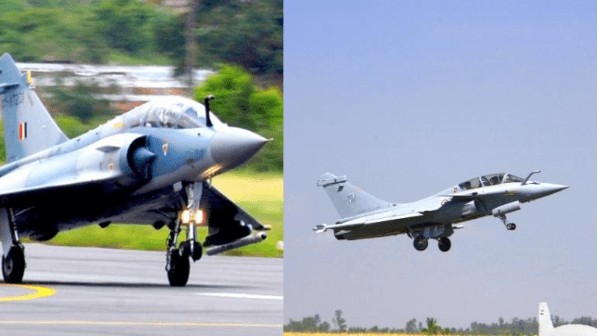
Why Pakistan’s F-16s Avoided Combat with India’s Mirage-2000 Fighters During the Kargil War: Strategic and Operational Insights
Fiona Nanna, ForeMedia News
7 minutes read. Updated 10:07AM GMT Fri, 26July, 2024
As the Indian Air Force (IAF) commemorates the 25th anniversary of its pivotal role in the Kargil War with the ‘Kargil Vijay Diwas Rajat Jayanti’ celebrations at Air Force Station Sarsawa, an exploration into the dynamics of this historic conflict reveals intriguing insights. The Kargil War, fought between India and Pakistan in 1999, showcased the remarkable efficacy of the IAF’s Mirage-2000 fighter jets, while the Pakistani Air Force (PAF) remained notably subdued. This article delves into why Pakistan’s F-16s “chickened out” during the conflict and examines the strategic and operational factors behind their limited engagement.
Commemorative Events and Honors
From July 12 to 26, 2024, the IAF has been celebrating the 25th anniversary of its victory in the Kargil War. At Air Force Station Sarsawa, Air Chief Marshal V.R. Chaudhari laid a wreath at the Station War Memorial to honor the memory of four IAF personnel who lost their lives when a Pakistani Stinger Missile struck their MI-17 helicopter on May 28, 1999. Squadron Leader R. Pundir, Flight Lieutenant S. Muhilan, Sergeant PVNR Prasad, and Sergeant R.K. Sahu were posthumously awarded the Vayu Sena Medal (Gallantry) for their bravery.
The Role of the IAF and the Deployment of Mirage-2000s
The Kargil War marked a high point for the IAF, which was tasked with supporting Operation Vijay launched on May 10, 1999. Although the IAF officially entered combat on May 25, its impact was substantial. Over the course of the conflict, the IAF conducted approximately 800 escort flights, 350 reconnaissance flights, and 5,000 attack missions. Initially, aircraft like the Mig-21 and Mig-23, along with helicopters, struggled due to the harsh mountainous conditions and the enemy’s fortified positions.
The turning point came with the deployment of the Mirage-2000 fighter jets, equipped with laser-guided bombs (LGBs). The Mirage-2000s proved instrumental in targeting key strategic locations such as Tiger Hill, Tololing, Point 5140, and a Pakistani supply base in the Batalik sector. Their precision and effectiveness were recognized by the Indian Army, which credited the Mirage-2000s with a significant impact on the battlefield.
Retired Air Chief Marshal B.S. Dhanoa highlighted the rapid adaptability of the IAF, noting that the integration of advanced weaponry into the Mirage-2000s was completed in just 12 days, contributing to the IAF’s pivotal role in the conflict.
Pakistan Air Force’s Limited Engagement
Despite the intense conflict, the PAF’s involvement was minimal. Retired Air Commodore M. Kaisal Tufail’s report reveals that the PAF was not actively involved in the initial stages of the war. The Pakistani Army’s late notification to the PAF and the lack of early involvement meant that the PAF was unprepared to face the superior IAF.
The PAF’s F-16s, the most capable aircraft in Pakistan’s arsenal, were used sparingly due to concerns over limited spare parts, exacerbated by American sanctions. Additionally, the PAF’s inability to effectively challenge the IAF’s superior aircraft and weaponry contributed to their reduced operational presence.
Strategic Considerations and Diplomatic Impact
The Kargil conflict was marked by its unofficial status, with neither side formally declaring war. Pakistan attempted to present the infiltrators as insurgents rather than soldiers, a claim not accepted internationally. The PAF’s limited engagement also stemmed from fears of escalating the conflict to a full-scale war, which could have further isolated Pakistan diplomatically.
US President Bill Clinton’s firm stance against Pakistan and the pressure from China to respect the Line of Control (LoC) further constrained Pakistan’s military options and diplomatic positioning. This geopolitical backdrop influenced the operational decisions of the PAF.
Superior Indian Air Force Tactics
The IAF’s aggressive patrolling and superior tactics played a crucial role in ensuring air dominance. The deployment of advanced Mirage-2000s, equipped with sophisticated missiles and electronic warfare systems, effectively deterred PAF F-16s from engaging in significant combat. Reports from retired IAF personnel highlight the Mirage-2000’s superior capabilities in both air-to-air and ground attack roles.
Air Commodore Tufail’s observations support this, noting that the PAF’s F-16 operations were suspended due to various operational challenges, including the effectiveness of the IAF’s air defense strategies and missile technology.
The Kargil War remains a significant episode in military history, illustrating the impact of technological superiority and strategic planning. The IAF’s performance with the Mirage-2000s and the PAF’s constrained involvement due to operational and strategic factors provide valuable lessons in modern air warfare.

